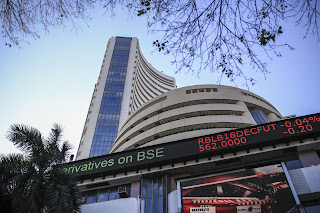Eco India
Friday, March 13, 2020
Top 5 Investments for Retail Investors
Top 5 Investments for Retail Investors
A bond is a debt instrument in which an investor loans money to an entity (typically corporate or government) which borrows the funds for a defined period of time at a variable or fixed interest rate.
A Government Security (G-Sec) is a tradeable instrument issued by the Central Government or the State Governments. It acknowledges the Government’s debt obligation.
A fixed deposit (FD) is a financial instrument provided by banks or NBFCs which provides investors a higher rate of interest than a regular savings account, until the given maturity date.
Physical Gold is the most popular form of investments amongst indians for their love and value towards this metal.SGBs are government securities denominated in grams of gold. They are substitutes for holding physical gold. Investors have to pay the issue price in cash and the bonds will be redeemed in cash on maturity. The Bond is issued by Reserve Bank on behalf of Government of India.
Equity is typically referred to as shareholder equity (also known as shareholders' equity) which represents the amount of money that would be returned to a company’s shareholders if all of the assets were liquidated and all of the company's debt was paid off.
Real estate is a tangible asset and a type of real property. Real property examples include land, buildings and other improvements,plus the rights of use and enjoyment of that land and all its improvements.Renters and leaseholders may have rights to inhabit land or buildings that are considered a part of their estate, but these rights themselves are not, strictly speaking, considered real estate.
Real property is not the same thing and should not to be confused with personal property. Personal property includes intangible assets like investments,along with tangible assets such as furniture and fixtures like a dishwasher.Also, even renters may claim parts of a home as personal property, provided you bought and installed the property with the lessor's permission.
Gold & Gold Jewellery
Gold & Gold Jewellery
Jewellery Demand
Gold jewellery represents the largest source of annual demand for gold per sector.This has declined over recent decades, but it still accounts for around 50% of total demand.
India and China are by far the largest markets, in volume terms, together accounting for over 50% of current global gold demand. The Asian and Middle Eastern markets are dominated by demand for purer, high-caratage gold.
Investment demand
Gold has unique properties as an asset class. Modest allocations to gold can be proven to protect and enhance the performance of an investment portfolio. Even so, globally, gold still only makes up less than one per cent of investment portfolios.
However, this is changing and investors of all sorts are coming to accept gold as a reliable, tangible long-term store of value that has moved independently of other assets. The annual volume of gold bought by investors has increased by at least 235% over the last three decades.
Our analysis shows that gold can be used in portfolios to protect purchasing power, reduce volatility and minimise losses during periods of market shock.
Central bank demand
The past decade has seen a fundamental shift in central banks’ behaviour with respect to gold, prompted by reappraisal of its role and relevance after the 2008 financial crisis.Emerging market central banks have increased their official gold purchasing, while European banks have ceased selling, and the sector now represents a significant source of annual demand for gold. Central Banks sold 7,853 tonnes of gold between 1987 and 2009; between 2010 and 2016 they bought 3,297 tonnes.
Technology
Gold has long been central to innovations in electronics. Today the unique properties of gold and the advent of 'nanotechnology' are driving new uses in medicine, engineering and environmental management.
Gold can be used to build highly-targeted methods for delivering drugs into the human body, to create conducting plastics and specialised pigments, or advanced catalysts that can purify water or air. It has also been used in dentistry for centuries. Although most technological applications use low volumes of gold, their impacts are very diverse and wide-reaching.
STOCK EXCHANGE
STOCK EXCHANGE
Stock Exchange should be understood as a market where stock buyers connect with stock sellers. Stocks can be traded on one or more of several exchanges such as the Bombay Stock Exchange (BSE) or the National Stock Exchange (NSE).
A stock exchange is a place where different financial instruments are traded—stocks, commodities, derivatives, etc.—bringing corporations and governments together with investors. Exchanges help provide liquidity in the market, giving sellers a place to liquidate their shareholdings. They also ensure trading takes place in a fair and efficient manner so important information such as prices can be transmitted to investors and financial professionals.
1 New York Stock Exchange(NYSE)
2 Nasdaq(NASDAQ)
3 Japan Exchange Group,Japan(JPX)
4 Shanghai Stock Exchange,China(SSE)
5 Hong Kong Stock Exchange(SEHK)
6 Euronext,European Union(EEA)
7 London Stock Exchange,UK
8 Shenzhen Stock Exchange,China(SZSE)
9 TMX Group,Canada(TSX)
10 Bombay Stock Exchange,India(BSE)
11 National Stock Exchange,India(NSE)
12 Australian Securities Exchange,Australia(ASX)
13 Deutsche,Germany(DAX)
14 SIX Swiss Exchange,Switzerland
15 Korea Exchange(KRX)
16 Nasdaq Nordic Exchanges,Copenhagen Stock Exchange
17 Stockholm Stock Exchange,Sweden
18 Taiwan Stock Exchange,Taiwan-Taipei(TWSE)
19 B3,Brazil
20 JSE,South Africa
21 Bolsas,Spain(BME)
INSURANCE
INSURANCE
We can define insurance as follows:
Insurance is a contract between the insurance company (insurer) and the policyholder (insured). In return for a consideration (the premium), the insurance company promises to pay a specified amount to the insured on the happening of a specific event ,like :-
Loss of Life(Death),Damage/Loss of Property,illness in Health
Top 3 popular Insurance
1. Life Insurance.
- Life (loss of Life)
- Term and Critical illness Insurance
- Loan/Liability Insurance
2. General Insurance.
- Automobile Insurance.
- 4 Weller Insurance
- Property Insurance (Fire/Earthquake/Etc.)
3. Health Insurance
- Medical Insurance i.e. when Hospitalized due to illness
Loss of Life(Death),Damage/Loss of Property,illness in Health
Top 3 popular Insurance
1. Life Insurance.
- Life (loss of Life)
- Term and Critical illness Insurance
- Loan/Liability Insurance
2. General Insurance.
- Automobile Insurance.
- 4 Weller Insurance
- Property Insurance (Fire/Earthquake/Etc.)
3. Health Insurance
- Medical Insurance i.e. when Hospitalized due to illness
- For Medicines for the illness
REAL ESTATE
Financial Institutions in India
Financial Institutions in India
The Financial Institutions in India mainly comprises of the Central Bank which is better known as the Reserve Bank of India, the commercial banks, the credit rating agencies, the securities and exchange board of India, insurance companies and the specialized financial institutions in India.
1. Reserve Bank of India (RBI) - it governs all the Financial Institute like Banks,NBFC,
Micro Finances,Co-operative Small Banks,
2. Public Sectors Banks - these have majourity equity held by e Government of India.
3. Private Sector Banks - these have majourity equity held by private intities
4. NBFC's - Non banking financial company
5. Small and Micro Finance - small and very small finances especialy for farmers and agriculture sector.
Subscribe to:
Comments (Atom)






